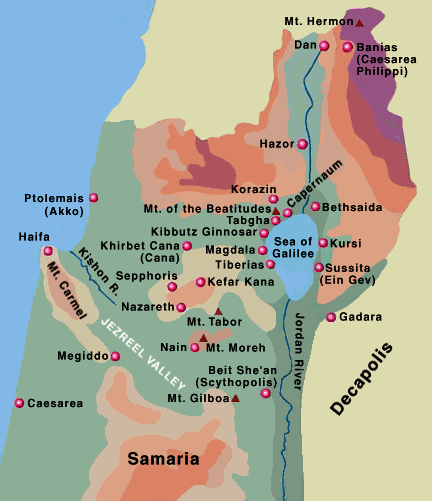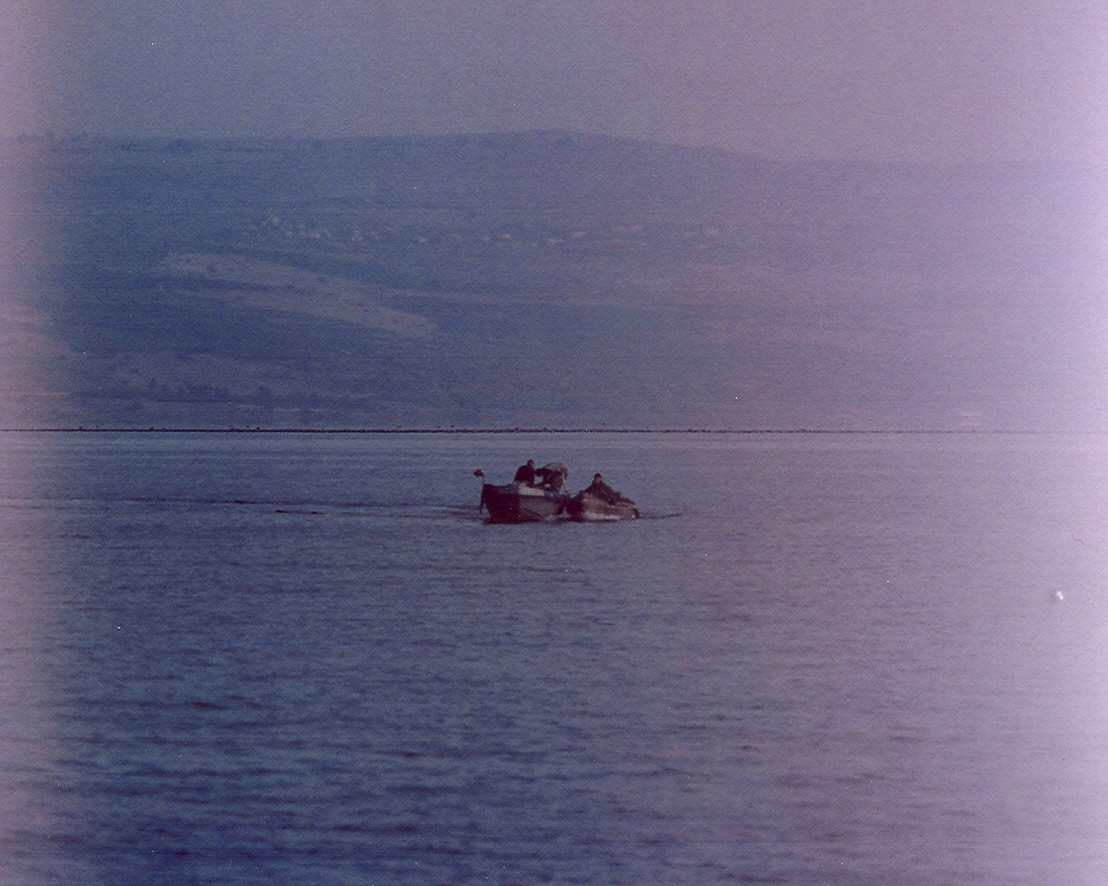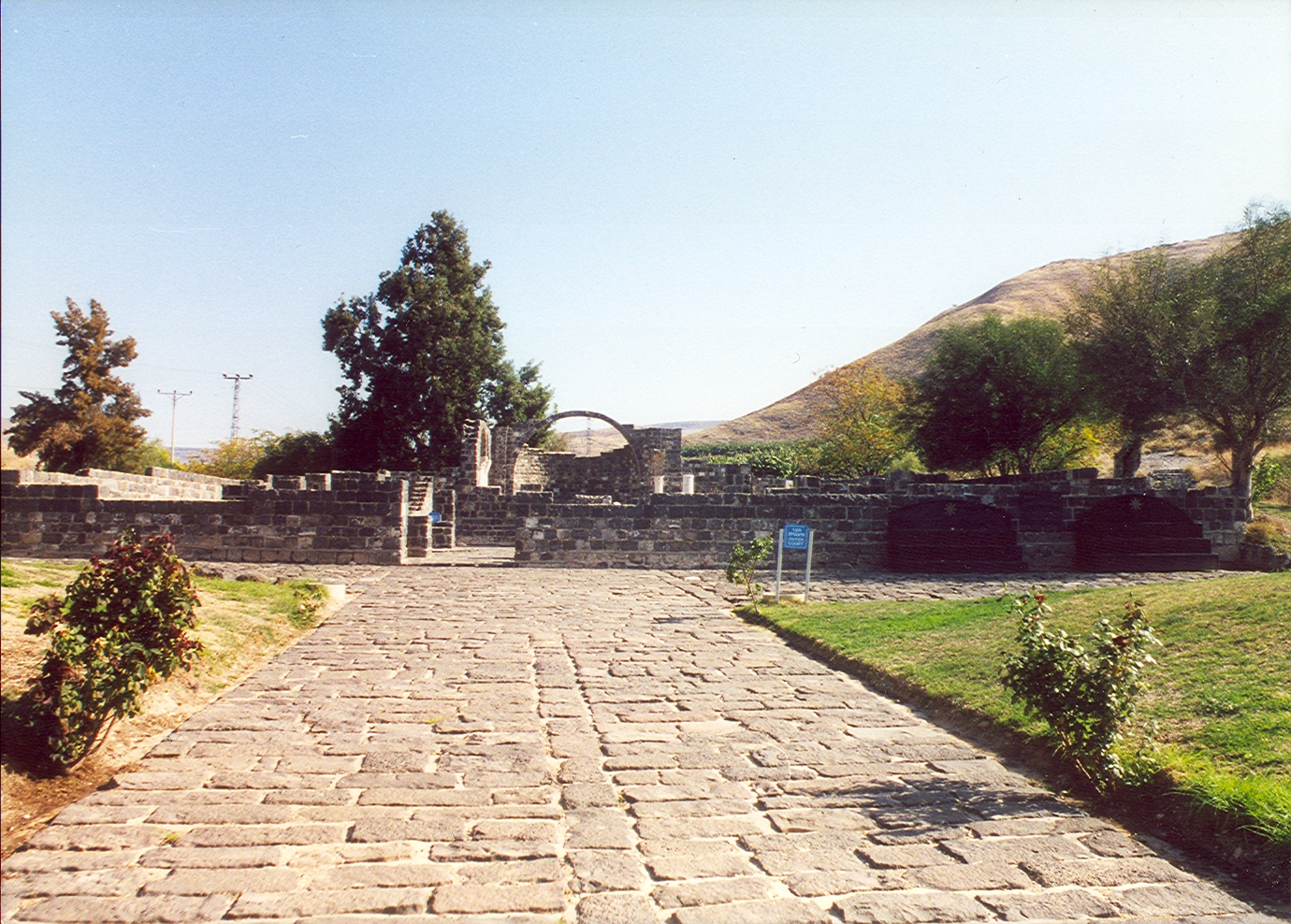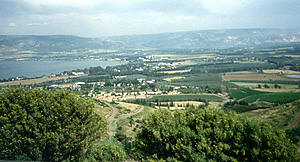

Sea of Galilee
Jesus went
throughout G alilee,
teaching in their synagogues, preaching the good news of the kingdom, and
healing every disease and sickness among the people." Matthew 4:23. "Galilee" is
one of the most famous place-names to Christians. Although Jesus was born in
Bethlehem, near Jerusalem, he lived most of his life in the region of Galilee,
in northern Israel. Most of his ministry and miracles took place
in the Galilee.
alilee,
teaching in their synagogues, preaching the good news of the kingdom, and
healing every disease and sickness among the people." Matthew 4:23. "Galilee" is
one of the most famous place-names to Christians. Although Jesus was born in
Bethlehem, near Jerusalem, he lived most of his life in the region of Galilee,
in northern Israel. Most of his ministry and miracles took place
in the Galilee.
Galilee is about 50 miles from north to south and 25 miles from east to west. Roughly speaking everything north and east of the modern city of Haifa is known as "Galilee," and now, as in ancient times, it is Israel's lushes region. In the spring the valleys and slopes become an ocean of wildflowers and blossoming trees. Beginning in March the area is covered by a vast blanket of green. The fertile land is a texture of orange groves, vineyards and fruit orchards, and it is the site of most of Israel's collective farms (kibbutzim).
After the death of
Solomon, the Galilee formed the northern part of the Kingdom of Israel. However,
the ancient boundaries are indistinct. In the 1st century AD, the Jewish
historian Flavius Josephus defined them as extending from the
Mediterranean Sea to the
west and the Jordan River to the east, from a line roughly corresponding to the
modern Israel-Lebanon border to the north and Samaria to the south. At the time
of Jesus, the Galilee was ruled by Herod Antipas, son of Herod the Great, with
the title of Tetrarch (from Greek "tetrarches"), literally "governor of a fourth
part" (of Palestine). Because of Galilee's great fertility, it was a very
populous part of the country. Josephus recorded that it had 204 villages, each
with a population of no less than 15,000, making a total of three million!
Although Josephus was governor of the Galilee for a time, historians believe the
figure is exaggerated. It does indicate, however, that the region was heavily
populated at the time of Jesus.
the north and Samaria to the south. At the time
of Jesus, the Galilee was ruled by Herod Antipas, son of Herod the Great, with
the title of Tetrarch (from Greek "tetrarches"), literally "governor of a fourth
part" (of Palestine). Because of Galilee's great fertility, it was a very
populous part of the country. Josephus recorded that it had 204 villages, each
with a population of no less than 15,000, making a total of three million!
Although Josephus was governor of the Galilee for a time, historians believe the
figure is exaggerated. It does indicate, however, that the region was heavily
populated at the time of Jesus.
Galilee is derived from the
Hebrew galil, meaning "circle" of "circuit." Isaiah (9:1) called the region "Galilee ha-gohim" or "Galilee of the gentiles" (NIV) or "Galilee of the nations" (KJV), reflecting the fact that from the 8th century to the 2nd century BC, it was controlled successively by the Assyrians, Babylonians, Persians and Seleucids. The region was not governed by the Jews until 80 BC, when Alexander Janneus subdued the area tempted to Judaist the population. Over these six centuries the regio n experienced constant migration as foreigners moved into the
region and freely mixed with the Jews. By the time of Jesus there were so much
foreign influence that Galileans could be recognized by their distinctive
accent, as in the case of Peter when confronted in the courtyard of the home of
the High Priest Caiaphas on the night of Jesus' betrayal: "Surely you are one of
them, for your
accent gives you away." (Matthew 26:73). Among Roman
administrators the Galilee had a reputation as a hotbed of subversive activity,
while the conservative elders in Jerusalem regarded the region as a heathen
province riddled with religious cults. This varied community was open to new
ideas and more alert to the realities of life in the Roman Empire than the aloof
inhabitants of Jerusalem who despised their northern cousins as country
bumpkins.
n experienced constant migration as foreigners moved into the
region and freely mixed with the Jews. By the time of Jesus there were so much
foreign influence that Galileans could be recognized by their distinctive
accent, as in the case of Peter when confronted in the courtyard of the home of
the High Priest Caiaphas on the night of Jesus' betrayal: "Surely you are one of
them, for your
accent gives you away." (Matthew 26:73). Among Roman
administrators the Galilee had a reputation as a hotbed of subversive activity,
while the conservative elders in Jerusalem regarded the region as a heathen
province riddled with religious cults. This varied community was open to new
ideas and more alert to the realities of life in the Roman Empire than the aloof
inhabitants of Jerusalem who despised their northern cousins as country
bumpkins.
Holy Land Greece Pilgrimages Pilgrimages Map Index Espaņol English Index